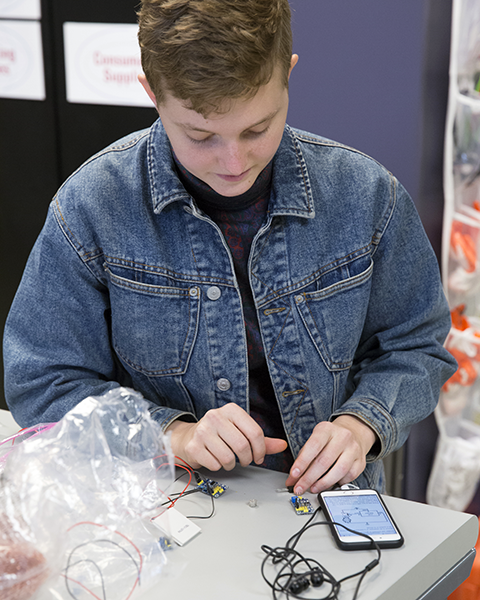
In the back of Cox Computing Center, through dimmed, relaxed lighting and students glued to glowing laptop screens, a bright room beckons curious students to wander in and discover MAKEmory, Emory’s campus makerspace (formerly known as TechLab). This semester, a group of three students wandered in and have returned every week since to incubate a new idea for social entrepreneurship.
Kieren Helmn, Anya Rosen-Gooding and Ryan James are the students behind the Vimband project. Vimband is the group’s solution to the Hult Prize’s call for a social enterprise that harnesses energy to transform lives around the world. The group’s creation is a wearable device that cools a user’s body temperature without the need for an air conditioning unit, fans, or ice.
“We started with a problem we wanted to tackle, and understood that global warming is one of the world’s biggest issues,” Anya explained. “And we wanted a solution that wouldn’t further global warming, but will cool people off.”
“We thought about something water-powered, or solar-powered, but there are so many companies already doing that,” Ryan added.
After defining their focus, the group created a plan that uses each team member’s strengths. Kieren, a rising senior majoring in business, and Ryan, a rising sophomore with an interest in consulting and computer science, took on marketing, designing, and pitching the idea. Kieren has a background in working with socially driven entrepreneurs focused on business development. Anya, a rising sophomore interested in health, led the 3D modeling and prototyping.
However, the students are branching beyond these roles and unifying their efforts into a learning process for all.
“We bring not only what we have [to the table], but we learn from each other as well,” Anya observed.
After Vimband was conceptualized and their plan defined, the team needed a way to execute their plan. MAKEmory provided the tools, space, and expertise to bring their idea to life.
“I was looking up how to do 3D printing, and had heard there was a 3D printer at Emory, so I just googled it. I have never visited this space before and didn’t realize they had this much to offer,” Anya recalled.
The “this much” Anya refers to are the many MAKEmory resources the group has used. The 3D printers were used to create casing prototypes and device components with both the lower resolution plastic printer and the higher resolution resin printer. To create a mold for their silicone wristband, the group used the CNC carving machine. Soldering and electronics equipment enabled the assembly and iteration of Vimband’s hardware. Even storage was useful, providing a space to store their silicone mold during the overnight curing process.
“Whatever creative mind you have, you’ll turn your ideas into action here,” Anya raved.

The team faced some challenges with MAKEmory, namely time constraints due to limited staffed hours. At times, the space was crowded when the team was trying to work at the same time as a workshop. Mainly, the group hopes to see more equipment at MAKEmory in the future. They suggest increasing the number of printers, offering a wider variety of electronics components, and providing a tool that can cut metal.
Although they couldn’t find quite everything they needed in one space, they felt supported on campus. Josh Medez, a post-doc from the Physics department, regularly gives them hour-long lessons on electronic schematics. The Physics machine shop covered their metal cutting needs. They were allowed access to the Physics electronics lab, which gave them soldering access when MAKEmory was closed.
Ryan summarized, “Asking for help was the biggest thing we learned.”
Again and again, the team highlighted the student staff at MAKEmory as the most valuable component of the space.
“What’s most useful is the people who work here. Ten times as many machines with only one knowledgeable person wouldn’t be as useful,” Anya said. “Everyone is so patient.”
As for the future of the Vimband project, the process is ongoing. The team has already won several campus competitions, such as the Siperstein Challenge and Emory’s Entrepreneurship Summit. In March, they flew down to San Francisco to compete in the regional round of the Hult Prize competition, and placed second out of the 60 teams there.
They are now applying for the Wildcard round with hope to be selected to participate in the 6-week London Accelerator. Feedback from the judges is fueling their drive to reiterate and continue pushing Vimband forward. They also hope to design and complete a study for their innovation, as well as work with investors to raise funds for scaling the project.
Leave a Reply